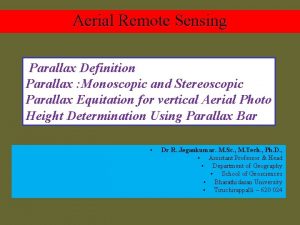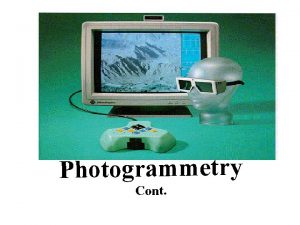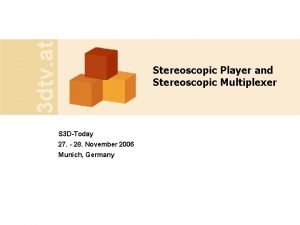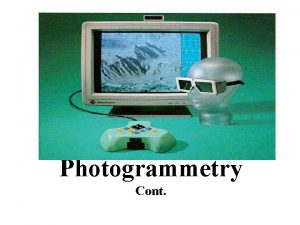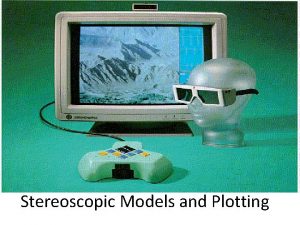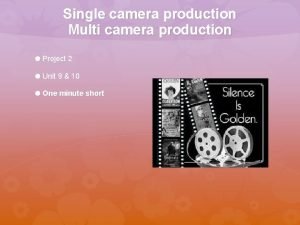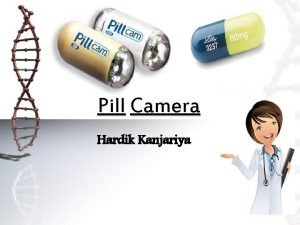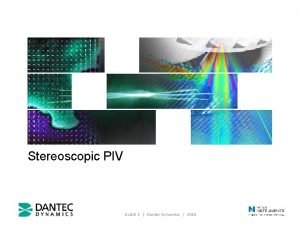Stereoscopy VRay Stereoscopic Camera Lesson Introduction Orientation This



















- Slides: 19


Stereoscopy: V-Ray Stereoscopic Camera

Lesson Introduction – Orientation • This presentation will take you through creating a Stereoscopic render • The information centers around the V-Ray Stereoscopic Camera • This lesson topic is approximately 15 minutes in length • Presentation covers all 3 Learning Cycles for the Lesson Topic – Lecture, Demonstration, and Activity

Lesson Topic: Stereoscopic Camera • Objective – Setting up and configuring Stereoscopic camera for proper stereo output • Configure the left and right eye renders for stereo viewing • Outcome – You will be able to set the scene up for a stereoscopic render

Lecture: Terminology • Here’s some terms to be aware of when thinking about the Stereoscopic camera – Stereoscopy – Creating the illusion of three-dimensional depth in two-dimensional images. – Eye distance / Interocular distance (interaxial separation) – The amount of stereo effect is defined, in part, by the separation of the camera lenses, which defines the relative parallax differential between the left and right eye images – Convergence / Focal plane – The point in 3 D space where the left & right eye images meet in the rendered image, causing objects to appear in front or past the screen to the viewer – Divergence – The need for the eyes to go wall-eyed, (i. e. rotate outward) to fuse the two separate left & right eye images into one – Stereo Window – Best imagined as photo frame where objects get be in 3 D viewing space behind, in the middle or outside of the frame

Lesson Topic: Stereoscopic Camera • Stereoscopy • Is a technique for creating or enhancing the illusion of depth in an image by means of stereopsis for binocular vision • Most stereoscopic methods present two offset images separately, one each to the left and right eye of the viewer • These 2 D images are then combined in the brain to give the perception of 3 D depth. Like magic. Science magic! • Binocular Vision - Your eyes are approximately two-and-a-half inches or 6 cm apart (‘Interocular distance’), so they see the same image from slightly different angles • Your brain combines these two images and you are able to gauge distance and depth

Lesson Topic: Stereoscopic Camera • Retinal Disparity • When we look at objects at different distances from us, the images of those objects will be projected on our retinas in slightly different locations for each eye • Our brain can interprets this “Retinal Disparity” and helps us to determine depth • In 3 D with a stereo camera the same thing happens: Each camera in the stereo camera sees the scene in slightly different horizontal positions • The Disparity is greater with a larger Eye Distance • We call this difference Parallax

Lecture: Stereoscopic Camera • Convergence – The convergence point of a 3 d image determines where the object appears in relation to the screen – – Our eyes focus & converge at a single point on the screen plane (where the image is projected or displayed) When viewing 3 D, our eyes focus on the screen, but we can perceive the image to converge on a point anywhere along the Z-axis The convergence point in 3 d imagery is the point at which the left and right eye images align Convergence in an image may be adjusted by angling the two lenses inward to each other, or by moving the left/right eye images horizontally in post-production – In a 3 d image, objects in front of this convergence point appear to be in front of the screen, and those beyond the convergence point appear to be beyond the screen

Lecture: Stereoscopic Camera • Real World Stereo Cameras • In the real world a Stereo camera is a camera with either two lenses or is a dual camera setup • This allows the two images to be combined to create an illusion of depth • The distance between the lenses in a typical stereo camera (the intra-axial distance) is about the distance between a typical person’s eyes

Lecture: Stereoscopic Camera • 3 D World Stereo Cameras • In the 3 d world a Stereo camera is a rig where two cameras are controlled with one set of parameters • This allows two images to be rendered at once • The distance between the two virtual lenses can be changed • V-Ray provides different ways that the two images rendered out can be viewed at once

Lecture: 3 D Viewing Systems • Active Viewing Systems • An Active 3 D Shutter system –Works by presenting the image intended for one eye on the screen while blocking the other eye's view with glasses. When alternating between the two eyes rapidly like this, your mind fuses the two images into a single 3 D image. • Passive Viewing Systems • Polarization systems - 2 projected images are superimposed onto the same screen through polarizing filters on the projector. The viewer wears low-cost eyeglasses which also contain a pair of opposite polarizing filters, one for each eye. Each filter only passes light which is similarly polarized and blocks the opposite polarized light, so one eye sees one image and not the other. • Interference filter systems - Uses specific wavelengths of red, green, and blue for the right eye, and different wavelengths of red, green, and blue for the left eye. Eyeglasses filter out the very specific wavelengths, allowing the wearer to see a full color 3 D image • Color anaglyph systems - The 3 D effect achieved by means of encoding each eye's image using filters of different (usually chromatically opposite) colors, typically red and cyan

Lecture: Stereoscopic Camera • The Stereo Window – The surface of your screen is the point of Zero Parallax – Best thought of as an empty photo frame • Parallax (Retinal Disparity) – The difference in position of the two camera / eyes – Positive Parallax – Objects appear behind the Stereo Window / Screen – Negative Parallax – Objects appear in front of the Stereo Window / Screen, appearing to “come out at you from the screen” The Red Plane shows the point of Zero Parallax in two differing positions

Lecture: Eye distance / (interaxial separation) • Interaxial Separation – Is the distance between the two cameras – – Defines in part the amount of stereo effect Should be close to a person’s inter-ocular distance – – The wider the interaxial, the more exaggerated the depth The smaller the interaxial distance, the less depth we perceive – Changing the eye distance Eye Distance: 2. 0 Eye Distance: 3. 0 Eye Distance: 9. 0

Lesson Topic: Stereoscopic Camera • Key Parameters for the V-ray Stereoscopic camera • Eye Distance – Specifies the eye distance for which the stereoscopic image will be rendered • Specify Focus – Allows you to manually specify the focus distance for the camera • Focus Distance – Manually specify the focus distance of the camera in scene units • Focus Method – Specifies the focus method for the two views • Interocular Method – Specifies how the 2 virtual cameras will be placed in relation to the real camera in the scene • View – Specifies which of the stereoscopic views will be rendered • Adjust Resolution – When turned on, this option will automatically adjust the resolution for the final image rendered • Panoramic Pole Merging - This section is used when rendering a panoramic view with stereoscopy (for example a Spherical camera with FOV=360 degrees). It allow us to avoid artefacts when looking upward and downward.

Lesson Topic: Stereoscopic Camera • Adding a Stereoscopic Camera to the scene • Stereo Camera Attributes can be added to any camera by selecting the shape node of the camera & select the Stereoscopic camera attributes from the Attributes>VRay menu • Another option is to use the Maya Stereo Rig - a rig of 3 cameras. The stereo effect can be controlled from the attribute editor of the centre camera. • If you already have 2 separate cameras for the left/right eye in the scene then you can create a V-Ray Stereo Rig - from "Create/VRay/Create Stereo. Rig from cameras"

Lecture Conclusion: Stereoscopic Camera • Eye Distance – Controls the Interaxial separation of the two images • Focus Distance – The distance from the camera to the point of convergence / the Focal Plane • Parallax – Objects with Positive Parallax will appear behind the stereo window, those with Negative Parallax will appear in front of it

Time to see it work! • Demonstration Cycle! • Watch while I demonstrate how to add and setup a VRay Stereoscopic camera

Time to do it yourself! • Activity Cycle! • Now it’s your turn!! • Use the provided scene file to set up a VRay Stereoscopic camera • The next slide provides some specific values I used for your reference

 Vray stereoscopic camera
Vray stereoscopic camera Image parallax in remote sensing
Image parallax in remote sensing Stereoscopic player
Stereoscopic player What is the function of the body tube
What is the function of the body tube Stereoscopic model
Stereoscopic model Stereoscopic player
Stereoscopic player Stereoscopic parallax
Stereoscopic parallax Pocket stereoscope
Pocket stereoscope Multi camera production examples
Multi camera production examples Camera movement
Camera movement Difference between ethnocentric and polycentric
Difference between ethnocentric and polycentric Pill camera introduction
Pill camera introduction Lesson 8 introduction to firestopping
Lesson 8 introduction to firestopping Maya metaball
Maya metaball Vray dirt material
Vray dirt material Vray animation settings
Vray animation settings Vray dispersion
Vray dispersion Vray blend
Vray blend Vray sun ozone
Vray sun ozone Vray sss
Vray sss

